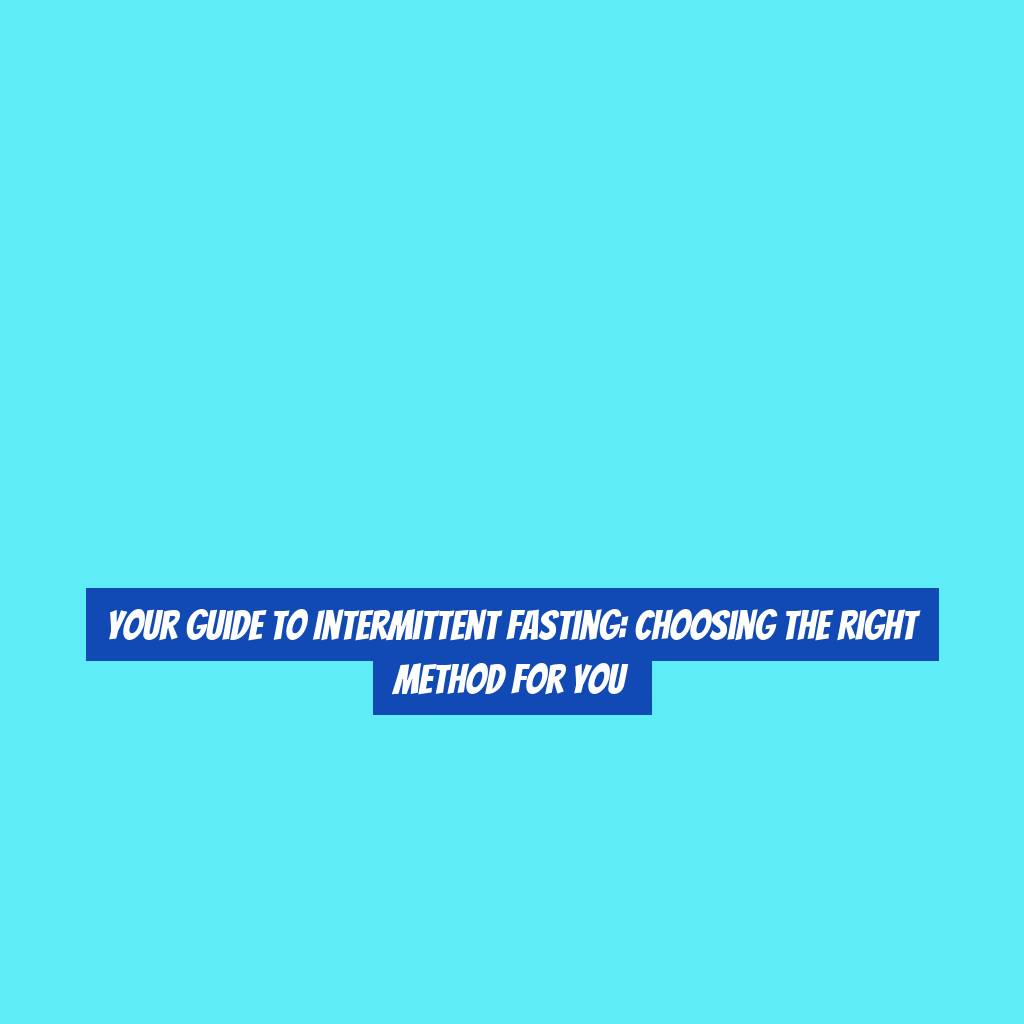Your Guide to Intermittent Fasting: Choosing the Right Method for You
So, youG??ve heard all the buzz about intermittent fasting and youG??re wondering if itG??s just another fad or if itG??s worth considering.
Well, letG??s be real for a moment – with so many different methods out there, it can be overwhelming to figure out which one is right for you.
But fear not, because in the next few minutes, youG??ll gain a clear understanding of the different intermittent fasting methods and how to choose the one that fits seamlessly into your lifestyle.
Whether youG??re a breakfast enthusiast or a late-night snacker, thereG??s a method tailored just for you.
Understanding Intermittent Fasting
Understanding Intermittent Fasting can be simplified as a pattern of eating and fasting cycles. ItG??s about when you eat, not what you eat.
The most common method is the 16/8, where you fast for 16 hours and have an 8-hour eating window. During the fasting period, your body depletes its glucose stores and starts burning fat for energy. This can lead to weight loss and other health benefits.
Another popular approach is the 5:2 method, where you eat normally for 5 days and restrict your calorie intake to 500-600 calories on the other 2 days.
The Eat-Stop-Eat method involves a 24-hour fast once or twice a week. Then thereG??s the Alternate-Day Fasting, where you alternate between days of normal eating and very restricted calorie intake.
Lastly, the Warrior Diet involves eating small amounts of raw fruits and vegetables during the day and having one large meal at night. ItG??s essential to choose a method that fits your lifestyle and health goals.
Keep in mind that while Intermittent Fasting can be beneficial for many people, it may not be suitable for everyone, especially those with certain medical conditions. Always consult a healthcare professional before starting a new diet or fasting regimen.
Exploring the 16/8 Method
The 16/8 method of intermittent fasting, also known as time-restricted eating, involves fasting for 16 hours and then consuming all your daily calories within an 8-hour window. This method is popular because itG??s relatively easy to follow and can be adapted to fit into most lifestyles. The fasting period can include the hours you spend sleeping, making it more manageable for many people.
During the 16-hour fasting window, itG??s important to stay hydrated by drinking water, herbal tea, or other non-caloric beverages. When the eating window begins, itG??s crucial to focus on consuming nutrient-dense foods to ensure that youG??re meeting your nutritional needs within a limited timeframe. This method doesnG??t restrict the types of food you consume, but itG??s recommended to prioritize whole, unprocessed foods to support overall health.
To make the most of the 8-hour eating window, itG??s helpful to plan your meals ahead of time and be mindful of portion sizes. This can help prevent overeating and ensure that youG??re getting adequate nutrition within the restricted timeframe. As with any dietary change, itG??s advisable to consult with a healthcare professional before starting the 16/8 method of intermittent fasting, especially if you have any underlying health conditions.
Uncovering the 5:2 Diet
Consider trying out the 5:2 diet, which involves eating normally for five days and then consuming a reduced number of calories on the remaining two days. This intermittent fasting method has gained popularity for its flexibility and potential health benefits. HereG??s why the 5:2 diet may be worth considering:
-
Flexibility: The 5:2 diet allows you to choose which days to restrict your calorie intake, offering flexibility to fit your schedule.
-
Potential Weight Loss: Some studies suggest that the 5:2 diet may aid in weight loss and fat loss, while also preserving muscle mass.
-
Simplicity: With only two days of calorie restriction per week, the 5:2 diet is relatively simple to follow compared to daily calorie counting.
-
Metabolic Health: Research indicates that intermittent fasting, such as the 5:2 diet, may improve various markers of metabolic health, including insulin sensitivity and cholesterol levels.
-
Adaptability: This method can be adapted to different dietary preferences, making it suitable for various lifestyles, including vegan, vegetarian, or omnivorous diets.
Exploring the 5:2 diet can provide an effective and sustainable approach to intermittent fasting, offering potential health benefits while accommodating individual preferences and needs.
Embracing Alternate-Day Fasting
Embracing alternate-day fasting can provide a flexible and effective approach to intermittent fasting, allowing for calorie restriction every other day while still enjoying regular meals on non-fasting days. On fasting days, you limit yourself to around 500-600 calories, while on non-fasting days, you can eat normally. This method can be more sustainable for some people compared to other forms of fasting, as it doesnG??t completely restrict you every day.
One of the key benefits of alternate-day fasting is its potential to aid weight loss. By consistently reducing calorie intake every other day, many individuals find it easier to create a calorie deficit, which is essential for shedding pounds. Additionally, some research suggests that alternate-day fasting may have positive effects on heart health, insulin sensitivity, and cellular repair processes.
However, itG??s important to note that alternate-day fasting may not be suitable for everyone. Some individuals may find it challenging to stick to the fasting schedule, and it can also lead to overeating on non-fasting days. As with any dietary change, itG??s crucial to consult with a healthcare professional before starting alternate-day fasting to ensure itG??s a safe and suitable option for you.
Finding Your Perfect Fit
To find the intermittent fasting method that best suits you, itG??s important to assess your lifestyle and dietary preferences before making a decision. There are several different approaches to intermittent fasting, so take the time to consider which one aligns with your needs and goals.
-
Consider Your Schedule: Take into account your daily routine and commitments. Some fasting methods may be more compatible with your schedule than others.
-
Evaluate Your Eating Habits: Think about your eating habits and preferences. If you enjoy larger meals, a method that allows for bigger meals within a shorter eating window may be more suitable for you.
-
Assess Your Energy Levels: Consider your energy levels throughout the day. Some fasting methods may have a greater impact on your energy, so choose one that aligns with your energy needs.
-
Reflect on Your Health Goals: Reflect on your health and wellness goals. Whether itG??s weight loss, improved metabolism, or other health benefits, choose a fasting method that supports your objectives.
-
Seek Professional Advice: If you have any health concerns or medical conditions, itG??s essential to consult a healthcare professional before starting any fasting regimen. Their guidance can help you choose the most appropriate method for your individual health needs.
Conclusion
Now that you understand the different methods of intermittent fasting, itG??s time to find the one that works best for you. Whether you prefer the 16/8 method, the 5:2 diet, or alternate-day fasting, thereG??s a method that fits your lifestyle and goals.
Experiment with different approaches and listen to your body to find the perfect fit for you. Remember, the key to success with intermittent fasting is finding a method that you can sustain long-term. Good luck!





